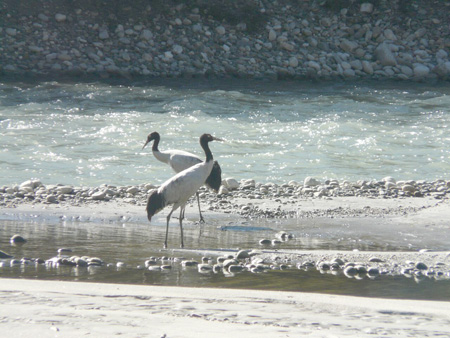Locals rejoice as the sacred cranes land safely at Zemithang
Staff Reporter
ITANAGAR, Dec 3: The sacred black-necked crane arrived once again in its wintering abode in the Pangcheng valley along the Nyamjang Chhu River here on 3 December.
As two cranes landed at Zemithang, locals, who consider the sacred bird as an embodiment of the sixth Dalai Lama, rejoiced at their auspicious arrival.
The sixth Dalai Lama, His Holiness Gyalwa Tsangyang Gyatso, born in the Monpa community in Tawang in 1683, has written about the majestic bird in one of his famous poetries.
A short 3-km stretch of the Nyamjang Chhu River between Brokenthang and Zemithang in Tawang district of Arunachal Pradesh is one of the only two regular, long-term wintering sites of the bird in India currently.
The other site is Sangti valley in West Kameng district of Arunachal Pradesh.
The bird is protected under Schedule-I of the Wildlife (Protection) Act, 1972 and is in the ‘vulnerable category’ as per the IUCN.
Although the birds were seen in the Chug valley in 2016, it is yet to be confirmed as a regular wintering site over a longer period of time.
The National Green Tribunal in a landmark judgement dated April 7th 2016 had suspended the environmental clearance granted to the 780 MW Nyamjang Chhu project, the barrage site and submergence of which will destroy the wintering site of the bird. The appeal had been filed by the Save Mon Region Federation.
Alarmingly, the Environment Impact Assessment (EIA) of the proposed project by the project developers had failed to record the importance of the wintering site and in fact did not mention the Black-necked crane even once.
However, subsequent to the environmental clearance, a study on the Tawang river basin commissioned by the Government of Arunachal Pradesh and conducted by the North Eastern Hill University, had unequivocally recorded the importance of this site as a wintering habitat of the black-necked crane and also concerns of local people regarding destruction of the winter home of the sacred bird due to the proposed project.
Therefore, the state government commissioned study could call the bluff of the study commissioned by the project developers.
The NGT in its April 2016 judgement had directed the Wildlife Institute of India (WII) to conduct an impact assessment of the 780 MW Nyamjang Chhu project on the black-necked crane.
A scientific paper published by leading Indian scientists in journal Zoological Research titled, ‘Status and distribution of black-necked crane (Grus Nigricollis) in India’ has already recommended that “To revive the wintering population of the species in eastern Himalayas, the Sangti valley and Pangchen valley of Zemithang should be declared as black-necked crane nature reserves and measures to maintain the ecological integrity of these areas should be taken on as a priority.”
The lead author of the paper is Dr Pankaj Chandan and co-authors include Dr Syed A Hussain of WII.
However, the recommendations of the WII study commissioned as a result of the NGT judgement and led by scientist Dr Gopi GV are yet to be placed in the public domain.
Although the birds have been coming to the site since time immemorial, their arrival has been documented by conservation organisation, WWF – India, in collaboration with local villagers for the past 10 years in a row, with the exception of last year.
Rajiv Gandhi University’s Ecology & Wildlife Biology (Department of Zoology), Assistant Professor Dr Daniel Mize has also been keenly following the wintering of the iconic bird for the past few years and writing about it in this paper.
This year, the arrival of the bird has already been documented photographically by local teacher Degin Dorjee on Monday and will be published in The Arunachal Times shortly.
Although the proposed dam was the primary threat to the black-necked crane’s wintering habitat at Zemithang, other relatively smaller but critical threats also need to be urgently addressed, such as the sand mining.
Although sand mining requires forest clearance from the Ministry of Environment, Forests and Climate Change (MoEFCC) and environmental clearance from the State Environmental Impact Assessment Authority (SEIAA), it has continued illegally with occasional stoppages on direction of district authorities.
Last year, the cranes could not land due to local disturbances due to various factors, including blasting for road construction.
The sacred birds took off just as they were about to land in this stretch of the Nyamjang Chhu River, much to the grief of the locals.
The state government through the Forest department and district administration needs to work proactively with all concerned agencies working in the area to ensure that Arunachal Pradesh can continue to proudly host the sacred birds during winter.
Other than ensuring that illegal sand mining is stopped, the government needs to urgently work on alternative sites for sourcing construction material as the wintering takes place in only a 3 km stretch of the Nyamjang Chhu River.
A sustainable construction material sourcing and use policy is the need of the hour in Tawang to protect this wintering site of the bird, immortalised in the sixth Dalai Lama’s poetry.

